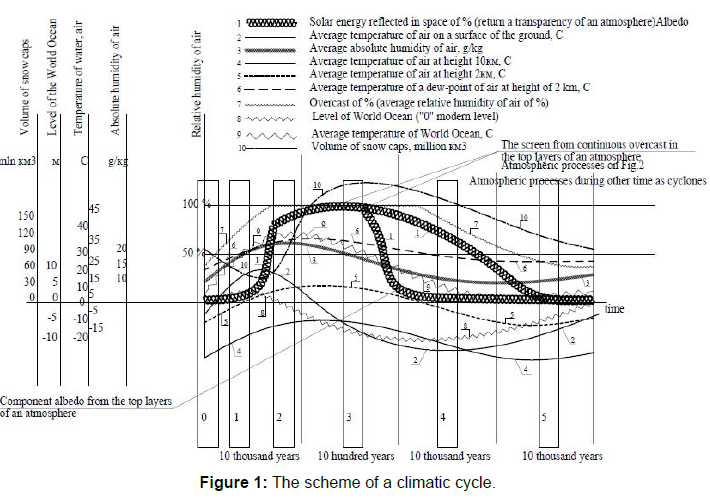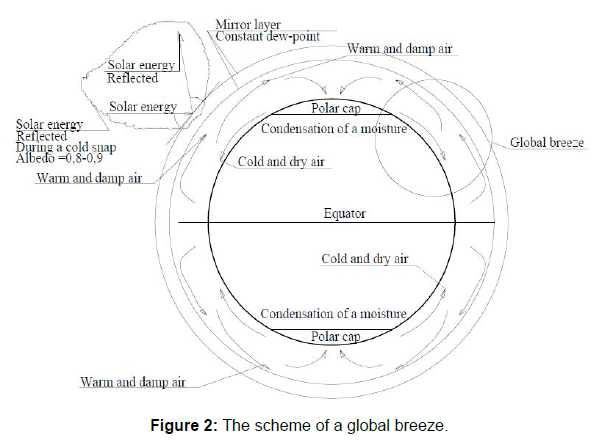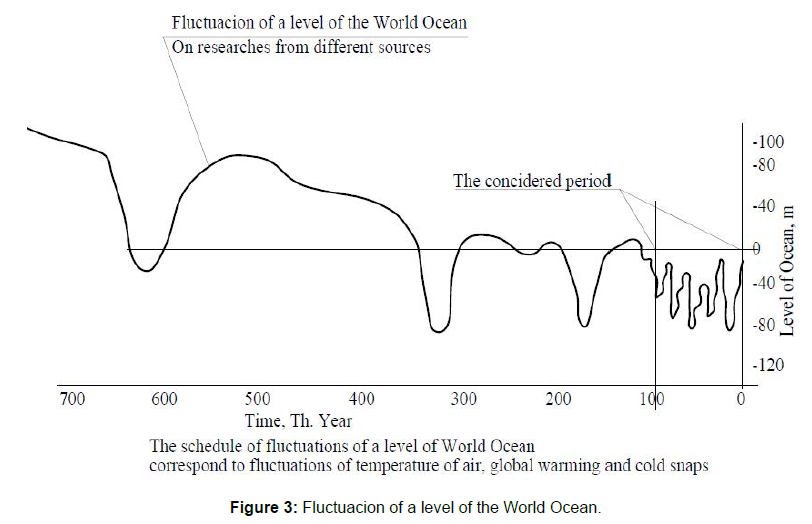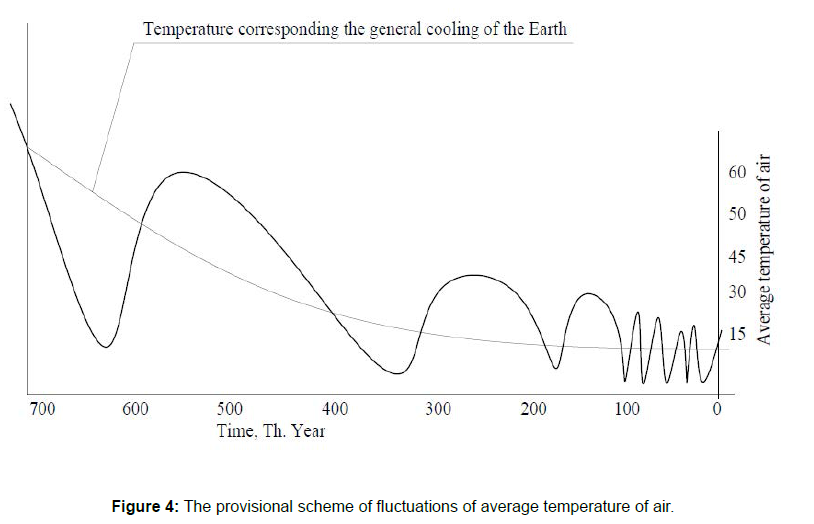Physics of Global Warming-Cooling Cycles
Received: 15-Jan-2022 / Manuscript No. EPCC-22-51717 / Editor assigned: 17-Jan-2022 / PreQC No. EPCC-22-51717(PQ) / Reviewed: 04-Feb-2022 / QC No. EPCC-22-51717 / Revised: 08-Feb-2022 / Manuscript No. EPCC-22-51717(R); / Accepted Date: 17-Feb-2022 / Published Date: 17-Feb-2022 DOI: 10.4172/ 2573-458X.1000259
Abstract
Nowadays the majority of scientists admit that the phenomena of climate warming and cooling of take place on the Earth. It is considered to be caused by some influences from the outside, either fluctuations of the solar activity, or the influence of human activity, or some other factors. Science does not offer any precise conclusion. It would be a delusion to completely deny the possibility of external influences. The proposed hypothesis considers climate fluctuations as a phenomenon caused by external conditions (influences), i.e. as a natural process.
major factor influencing the climate is considered to be optical properties of the atmosphere which vary depending on its structure and condition. According to the hypothesis these processes in normal conditions acquire an oscillatory character. The process has a multifunctional dependence. All processes together and each separately are subject to thermomechanical and to optical-mechanical calculations.
The present article is the expanded English version of the previously published article in the Eastern European Scientific Journal №1 2016г. The purpose of this publication is to popularize the proposed hypothesis and to find recognition on the international level. Video data on the topic are presented on YouTube « Глобальное потепление. Лекция в шк.2 Туапсе». https://www.youtube.com/watch?v=XCLZXEfs7-Y&t=9s.
A significance statement
Article has for an object to show physics of cycles of fluctuations of a climate on the Earth. The fact of fluctuation of a climate proves to be true the fact of fluctuation of a level of the World ocean. These fluctuations have direct dependence. Studying of this process will allow calculating mathematical model of prospect of development of this process.
Keywords: Global Warming and a Global Cooling; Fluctuationsof the World Ocean Level; Heat- and- Moisture Exchange in theAtmosphere; Continuous Overcast
Keywords
Global Warming and a Global Cooling; Fluctuations of the World Ocean Level; Heat- and- Moisture Exchange in the Atmosphere; Continuous Overcast
Introduction
It is necessary to admit that the modern science confirms the fact of climate fluctuations on the Earth.
It is also necessary to make a division of average temperature changes processes on the Earth. The long-term period of an average temperature change process lasts million years and the short-term period of an average temperature change process on the Earth lasts hundred years. In the long-term period, the cooling of the Earth is observed. In the short-term period, there is an oscillating process of average temperature change on the Earth. The objective proof of the above-mentioned process is the oscillating process of the World Ocean level. The process of cooling in the short-term period has a very rapid character and the process of warming is much slower. These processes can be explained by thermomechanical calculations. Nowadays there is a process of warming and the objective proof of it is an ablation. During the last 100 years the level of the World Ocean has increased up to 17 cm. According to the thermomechanical calculations data the speed of ablation will be increasing in future.
The popular versions of both cooling and warming cycle’s explanations are beneath criticism. For example, Milankovich cycles from the point of the energy conservation law do not have any scientific ground.
Physics of warming-cooling cycles
During the warming period polar caps melt, the level of the world ocean rises, the average water temperature increases, and the average air humidity goes up. During this period the atmosphere is characterized by cyclonic heat- and- moisture exchange. It seemed that the average humidity of the atmospheric air is a constant value and it is supported by the balance of evaporation and precipitation. However, in due course the average humidity in the atmosphere increases. At a certain moment, as humidity increases, there appear conditions in the upper atmosphere to create the dew point effect. This effect represents stable (continuous) formation of overcast over the entire atmosphere surface to achieve a stable dew point. The stability of the dew-point is supported by the alteration character of the atmospheric air circulation from cyclonic to a global breeze. The stable continuous overcast is a turning-point in optical and thermomechanical processes on the Earth surface, in the atmosphere. Continuous overcast immensely increases the amount of the reflected solar energy, accordingly the quantity of the solar energy absorbed by the Earth decreases, the cooling process commences.
Warming and cooling cycle stages are represented in the graphic scheme. The characters of the curves are mainly determined speculatively (Figure 1).
Area 0: The stage corresponds to the time of thousand years ago from the present stage. Active warming. Water and air temperatures increasing, polar caps melting [1,2].
Area1. Modern processes. Continuation of the previous stage processes. Temperatures and air humidity growth.
Area 2. The critical stage. The average air humidity has reached the dew-point effect. A significant part of solar energy is reflected into space, optical properties of the atmosphere have changed. Continuous overcast is the screen and does not allow solar energy to reach the Earth surface. The radical process of cooling is beginning. Atmospheric processes are acquiring the character of a global breeze. Warm and damp air from the equator is directed to poles in the upper atmosphere and all these factors support the constant dew-point effect and continuous overcast. In the lower atmosphere the dry and cold air moves from the poles to the equator. The process is presented in Figure 2.
The commencement of polar snow caps growth. The stability of this process is maintained significantly by the difference of water temperatures in the World Ocean, the source of heat and cold of the upper atmosphere and the cold of poles. The upper atmosphere at this stage is the screen to receive the solar energy heat on the Earth and the source of heat and circulation of the atmosphere is the heat of the World Ocean. The average air temperature decreases. It is a cooling period.
Area 3. The continuation of the previous stage processes. The water of the World Ocean cools down. The process of water evaporation from the surface of the World Ocean dies away, the level of the World Ocean decreases. Polar caps reach maximal sizes. Continuous overcast gradually dissipates due to the moisture lack in the atmosphere. Atmospheric processes are still of a global breeze nature.
Area 4. The turning point of transition to warming. The World Ocean has cooled down. Infringement of the continuous overcast owing to the ocean cooling and the stoppage of the moisture supply to the atmosphere. Solar rays reach the Earth surface through the transparent atmosphere. The cyclonic processes are formed in the atmosphere in the areas of a terrestrial surface warming. The global breeze is gradually replaced with cyclones. There are processes of inertia, i.e. warming is beginning, but the phenomena of cooling are also taking place.
Area 5. The beginning of warming with a real temperatures’ growth. The atmosphere circulation is transformed from the global breeze into cyclonic circulation. Snow caps are melting and the increase on the World Ocean level is beginning.
So, the climate transition process to cooling can be explained by the sequence of such phenomena as the world ocean heating, the increase in the average atmosphere humidity, transformation of cyclonic atmosphere circulation into a global breeze, the continuous overcast formation, the reflection of practically all solar energy into space (substantial reflectance growth). The transition process from the cold climate to warm: the ocean cooling, the infringement of continuous overcast, the solar energy reaches the Earth surface, heating of the atmosphere.
This hypothesis explains both the cyclicity of the climate cooling and warming phenomena by means of well-known thermomechanical processes.
The role of the climatic fluctuation cycles in the Earth temperature mode
It is also necessary to note, that the cycles of global warming and global cooling occur along with the decrease in the Earth average temperature as well as the Earth cooling in the long-term period (Figures 3 and 4). The process of the Earth cooling occurs in compliance with the Second Law of Thermodynamics. In other words, the resultant vector of temperature fluctuations on the Earth is directed to the Earth temperature decrease in the macro process. In formation of the world picture it is necessary to accept in addition to the Earth cooling, a constancy of water quantity (in all transformations), the change of the Earth geomorphology, namely, increases in thickness of the Earth’s crust in the process of cooling.
Characteristics of the fluctuation cycle
As a whole, the fluctuation process has a fading character. The fluctuations amplitude and the fluctuations period decrease in accordance with the time. The attenuation of oscillatory process is a topic of specific researches.
The following moments are typical of the cycles at the present stage of the Earth’s life. Since the direct reflection of the climate fluctuations is the World Ocean fluctuation level, it is sufficient to study this process. So, for example, the cooling stage is characterized by the swiftness of the process in time. The duration of this stage is measured in hundreds of years. The duration of the warming stage is measured in thousands of years. The difference in duration is explained by thermomechanical and thermodynamic processes.
The cooling stage is characterized by: the average air temperature decrease, the World Ocean level decrease, drying of internal reservoirs, growth of polar snow caps. The warming stage is characterized by: the melting of polar snow caps, the World Ocean level increase, and the average air temperature increase. At the initial stage of warming hollows of internal reservoirs adjoining to polar snow caps (for example, Pontus-Caspian hollow, Great Lakes hollow) are filled. At the end of the warming stage internal reservoirs are dried up.
Conclusions
Fluctuations of the air temperature on the Earth are of the natural cyclic character. The cycles of global warming and cooling are of the natural character and are caused by natural phenomena. The anthropogenic impact is able to only distort these processes, but not to control them.
Acknowledgements
The preliminary hypothesis expertise was carried out by Dr. E.A. Yaili, Tuapse Branch of the Russian State Hydro meteorological University (SPb). For the first time the adapted version of the hypothesis was published in the journal «Eastern European Scientific Journal», Editor-in-chief N.P. Khvataeva.
References
Citation: Kuzminov I (2022) Physics of Global Warming-Cooling Cycles (Hypothesis). Environ Pollut Climate Change 6: 259. DOI: 10.4172/ 2573-458X.1000259
Copyright: © 2022 Kuzminov I. This is an open-access article distributed under the terms of the Creative Commons Attribution License, which permits unrestricted use, distribution, and reproduction in any medium, provided the original author and source are credited.
Share This Article
Recommended Journals
Open Access Journals
Article Tools
Article Usage
- Total views: 1594
- [From(publication date): 0-2022 - Nov 21, 2024]
- Breakdown by view type
- HTML page views: 1259
- PDF downloads: 335




